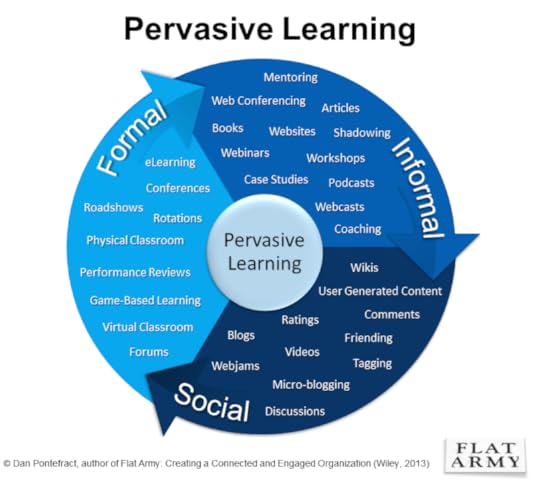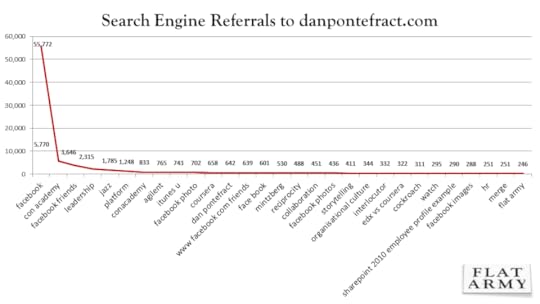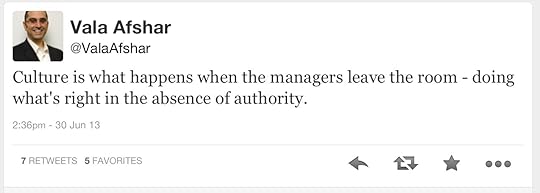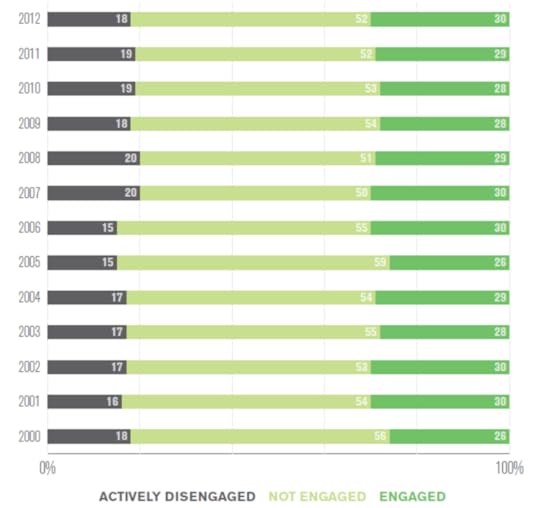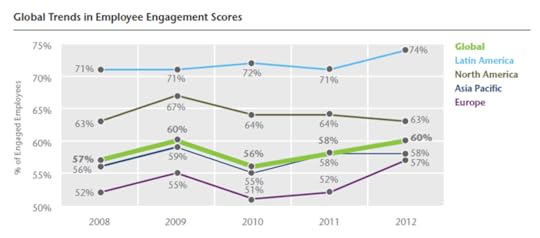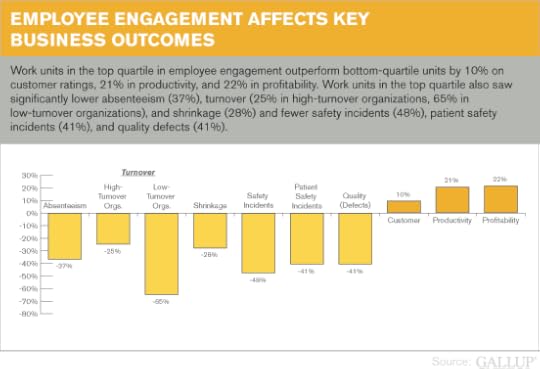Dan Pontefract's Blog, page 47
September 3, 2013
Social as a Weapon of Class Destruction
“Who can think without horror of what another widespread war would mean, waged as it would be with all the new weapons of mass destruction.”
Archbishop of Canterbury Cosmo Gordon Lang, December, 1937 London Times newspaper
The aforementioned line is recognized as the first known use of the term ‘weapons of mass destruction’. But today, in 2013, I want to discuss a new weapon — a weapon of class destruction — and that weapon is social.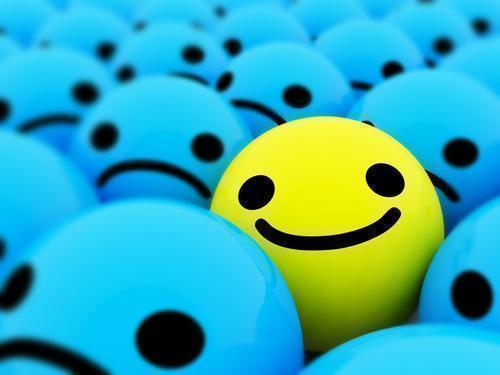
Let’s first define what I mean by ‘class’.
I’d like the term class in my social as a weapon of class destruction thesis to denote two things for purposes of this piece:
societal & organizational status
the physical place we go to learn
In society (and in our organizations) there remains both a visible and at times invisible ranking system of class. In society in general, we judge those with more money and with less money. We analyze people’s socioeconomic status including where they live, what type of work they perform, and even their title at work itself. Sociologists define the theory ‘social stratification’ as Peter Saunders does in his 1990 book, “Social Class and Stratification“.
Harold Jarche recently wrote “The Social Imperative” where he states:
“Better social relationships (non-hierarchical and not based on dominance of others) can make for healthier populations. In addition, they are the only way our collective intelligence can adapt to increasing complexity. Becoming more social is not just a new business driver but also a societal imperative.”
Social as a weapon of class destruction can help us not only demystify the social stratification that manifests in society, it can assist and perhaps mitigate a culture of fear that rests in many organizations today. This culture of fear is often as a result of hierarchical systems (a hierarchy for the sake of hierarchy) and managers who breed fear as opposed to disrupting the system and encouraging openness, collaboration and, well … being social.
By being social (both the in-person face-to-face kind and through the use of collaboration tools) we will find not only healthier populations but healthier organizations.
At SAS, they have “The Hub” and at TELUS (where I’m currently employed) we recently improved our existing social collaboration experience by launching “TeamHub”. (I’ll write about this later) After four weeks, over 6,000 people are already on TeamHub (and specifically cloud-based Jam) utilizing the platform for connecting, collaborating, learning and sharing. In each case, using social as a weapon of class destruction actually unites the organization, whilst equally breaking down silos and ‘hierarchy for the sake of hierarchy.’
With this new weapon, we can break down the hierarchical status symbol in our organizations and introduce what Ronald Burt refers to as ‘near peers‘ “through whom opinion and behavior spreads through connections turn out to be network brokers”. Social can break down the class structure into a network of knowledge and innovation brokers.
And if our new weapon is breaking down the hierarchy it might as well break down the belief that all learning must occur (or does occur) in a class(room).
It doesn’t.
Charles Jennings wants us to consider ‘experience rich continuous learning‘ where he says, “by supporting and encouraging learning within the workflow, and through and with others, a culture of continuous learning will evolve.”
It can.
The use of social as a weapon to annihilate any class(room) based learning is missing the point and therefore misguided. That stated, when social is used as a weapon of class destruction we’re referring to those that believe learning only occurs in a class(room). We must compliment any class based learning opportunity with social, be it pre and/or post class learning with the use of social behaviours and of course social collaboration tools. For extra credit you will utilize social tools during the class event itself.
In summary, you may take umbrage with my use of the term social as a weapon. There probably isn’t a more friendlier term on the planet than social, so why am I turning it into a weapon?
I’ll tell you why.
Our organizations are still stuck with the ideology that those with fancier titles know more, can do more, and therefore get paid more to tell us what to do more. That’s why life happiness scores are flat and that’s why employee engagement levels remain unchanged (and at alarmingly low levels) for the past 15 years. It’s why Global Silicon Valley (GSV) Advisors predict global corporate classroom based learning expenditure will increase from $356b in 2012 to $524b in 2017; we’re stuck thinking class(room) based learning is the only (and perhaps best) way in which to learn.
That’s why we need social as a weapon of class destruction.
390 total views, 372 views today
Dan's Related Posts:Learning 2.0 is Dumb: Use ‘Connected Learning’ InsteadLearning by OsmosisApparently, Organizational Culture is CrapThe Hare, the Tortoise and the Jackass of Social HRHierarchy starts with a ‘Higher Arc & Key’
August 29, 2013
Pervasive Learning Graphic from Flat Army
If you’ve read Flat Army, you know there are five key models that make up a Flat Army leader and a Flat Army organization. If you haven’t read it … well, how can I sway you to remedy that?
One of those models is something I call “Pervasive Learning“.
You can watch a short video (2 1/2 minutes) about me describing what is in the chapter that utilizes the term Pervasive Learning (the chapter is called Learning at the Speed of Need) … and, now, you can download the Pervasive Learning graphic if you so desire.
359 total views, 92 views today
Dan's Related Posts:Flat Army: Chapter 9 Overviewthe FLAT ARMY cheat sheetDownload Chapter 1 for Free – Flat Army: Creating a Connected and Engaged…Flat Army: Chapter 11 OverviewFlat Army: Chapter 5 Overview
August 28, 2013
40% of the search traffic to danpontefract.com is because of the term ‘facebook’
I thought I’d make use of the Jetpack statistics function that comes with my WordPress installation of this site to determine what terms people entered into a search engine over the past year that brought them directly to danpontefract.com
First of all, I suppose I should thank Mark Zuckerberg for coming up with the term ‘facebook‘.
Wow.
Second of all, I suppose I should have written a book about ‘facebook‘ and called it “Flat Facebook: How To Get More Hits To Your Website“.
Seriously.
The graphic below illustrates the top 30 terms used in various search engines like Duck Duck Go, Yahoo! (do they still use the exclamation mark?), Bing … oh, and something called Google.
Click to enlarge.
The total number of search engine referrals is 136,003. If I look at the entire list (you can too by viewing this PDF file) I reckon 40% of the searches have some version of the term ‘facebook‘ as an entry point into this site.
40%!!!
So, be forewarned … for the rest of 2013, every post will now have the term “facebook” in it and not “Flat Army“.
Note this isn’t the total number of visits to the site, simply the entry point from a search engine search term. I’ve got a brother and a sister that must visit this site roughly 500 times/day each to find out what the heck I’m doing in my life and to help pad the overall visitor stats.
263 total views, 22 views today
Dan's Related Posts:Should Companies Allow Facebook at Work?The 10 Winners of Flat Army Copies Are …Pervasive Learning Graphic from Flat ArmyDo We Need Textpectations?I Unfriended You On Facebook. Are We Still Friends?
August 23, 2013
Redefining the Social Employee
 Back in the day, and by day I’m referring to PI (pre-Internet), the social employee was someone who knew how to network, to dialogue and to get things done without the aid of online systems or tools.
Back in the day, and by day I’m referring to PI (pre-Internet), the social employee was someone who knew how to network, to dialogue and to get things done without the aid of online systems or tools.
Remember Sally?
She knew everyone and anyone who she met in the elevator. In the cafeteria there wasn’t a day that went by where there wasn’t a throng of peers hovering around her, deep in conversation about company-related dialogue. She truly was a people person.
How about Darryl?
If you needed some form of company intelligence, insight into current practices or simply a name to get something you needed done, Darryl seemed to know everyone at the company. He was the connector, or as I like to say, the interlocutor. The more Darryls there were at the company, the more successful your company was.
These days, with the advent of collaboration platforms, remote work styles and the quest to define an external digital DNA at sites like LinkedIn, BranchOut or Quora, the social employee has taken on a diversified definition. And if he or she hasn’t, well, the word anachronistic comes to mind.
The default action of “social employees” can no longer simply be to network in a physical way. Sure, this will remain important; however, no matter who you are in the corporate hierarchy, everyone needs to augment the physical with the virtual. The social employees of today and tomorrow must take into consideration their abilities to actually be “social” when physical means may be dwindling.
Let’s look at a couple of examples.
Janice is a vice president of R&D at a company that has grown from 10,000 to 20,000 employees during the past three years. The company’s headquarters, where she works, has seen a population increase of 10 percent whereas the other eight employee sites are up anywhere from 20 percent to 135 percent. Even though she is the VP of R&D and is at company headquarters, it behooves Janice to increase her social employee credibility with those who may be working outside of headquarters. What knowledge, insight, experience or ideas might these virtual employees bring to her portfolio that she might not tap into if she defaulted to her normal face-to-face way in which to network? Janice cannot rest on the laurels of her jovial personality that people at headquarters might see on a daily basis to further her performance. She must consciously sort out how she is going to augment her social employee intelligence to not only help her own cause, but to demonstrate to the organization that as a VP, leadership styles can in fact change and that her “social employee” status is going to include all forms of digital relationship building.
Fu-Xing is a project leader. He gets rotated from project to project at the pharmaceutical company he works for. Typically, his projects have been made up of employees working at three of the local offices, but the next two projects he is slated for in Q3 and Q4 involve a much larger scope, team and geographical array of employees. In fact, one of the projects consists of two teams and a total of 30 employees whom he has never met face-to-face and who work in other time zones. Fu-Xing has always conducted his project meetings face-to-face and any follow-up has normally consisted of physical jaunts to the desk of team members. Fu-Xing, as a social employee, now has to incorporate into his project leader role other attributes such as discussion forums, online polls, Web conferencing, micro-blogging, team wikis and even blogging to help facilitate the goals of the team. He no longer can rest on the laurels of his previous project management and collaboration style.
The new social organization has an itch and that itch ought to be scratched as soon as possible. The employees of today and tomorrow (inclusive of leaders) must be aware of both their face-to-face and digital social employee intelligence.
The social employee is rising. Beware of the tide.
482 total views, 236 views today
Dan's Related Posts:Flexible Working Works5 Use Cases for a Corporate YouTube in OrganizationsHas the Economic Meltdown & 9/11 Impacted our Definition of Teams?Five Uses for Virtual Worlds in the WorkplaceThe Social C-Suite
August 21, 2013
I Detached on Holiday. I Didn’t Unplug. You Should Too.
 I’ve recently returned from 3 1/2 weeks away with the three ‘goats’ and Denise where we enjoyed the fine Puget Sound sea air of Gig Harbor. Ever since I can remember, Denise and I take 3 weeks of holiday in the summer usually coinciding with the last week of July and first two weeks of August. We might venture to Europe or parts of Canada … but this was our first time in the USA for three weeks straight and with the three goats.
I’ve recently returned from 3 1/2 weeks away with the three ‘goats’ and Denise where we enjoyed the fine Puget Sound sea air of Gig Harbor. Ever since I can remember, Denise and I take 3 weeks of holiday in the summer usually coinciding with the last week of July and first two weeks of August. We might venture to Europe or parts of Canada … but this was our first time in the USA for three weeks straight and with the three goats.
We nearly FedEx’d the goats to Siberia half way through the trip, but that’s another story for another day.
I also have something to confess. I lied.
Not about anything from above, but with my ‘out of office‘ message.
If you received one from me, I mentioned in it that I was on my annual ‘acoustic and unplugged‘ summer tour.
I wasn’t unplugged at all. In retrospect, it was a lie. A bit like Google’s 20% time.
But there is a difference I’d like to share with you. Whilst I lied and was totally plugged in with my iPad and Blackberry Z10 (yes, I really like it – give them a break for crying out loud) fluidly connected to the interwebs … I was fully and completely detached from work, from email and from any of my current deliverables.
I may not have unplugged but I detached.
And the team at TELUS — where I currently work — were just fine while I detached.
While I was plugged in overlooking the beautiful waters of Puget Sound, I was doing a lot (I mean a lot) of reading for book #2. I was doing some writing as well, and as you know, I like to write in Evernote so being plugged in was somewhat handy at times. I even played a few online games.
And yes, we had fun with the goats as well. Do you know how many crabs there are to catch in those waters?
But whenever they find me or I seek them out, the statistics of people working during a holiday sends me to the infirmary. For example:
A Pertino Survey found 47% of Americans say relaxing on vacation means knowing they’re never more than a few clicks away from the office
Harris Interactive found 61% of employees planned to work while on holiday in 2013 up from 52% in 2012 and 46% in 2011
Robert Half Management found 64% of Canadian CFO’s they polled check in with work while vacationing
And this Vacation / Work-Life Balance (not) infographic depicting Americans and their vacation plans will surely send you to the nearest watering hole
While Baratunde Thurston may have “Left The Internet For 25 Days” — providing some compelling reasons why to unplug in his Fast Company piece — I’m advocating a different philosophy. In fact, research proves email ‘vacations’ — or detachment as I refer to it — can decrease stress and increase concentration.
You should detach while on holiday … not unplug.
You simply need the discipline to not do ‘work’ work while being plugged in. You need to detach yourself from work.
Think you can do it? Think you can detach and remain plugged in?
233 total views, 233 views today
Dan's Related Posts:A Summer of Anonymity is OverI’m Not Scared of Email; I Developed a System called DADDIOInterlocutors of 2012 (the goats are better for it)Our Three Young Children Blog … Here’s WhyAn Infographic Depicting Learning & Collaboration in Action
July 2, 2013
Apparently, Organizational Culture is Crap
 The one thing we can be assured of until humans safely land and colonize Mars is “organizational culture” will continue to be a topic of conversation. It’s about on par with the Leadership vs. Management debate — as John Kotter rehashed earlier in 2013 — but I’ll save my thoughts on that meme for another day.
The one thing we can be assured of until humans safely land and colonize Mars is “organizational culture” will continue to be a topic of conversation. It’s about on par with the Leadership vs. Management debate — as John Kotter rehashed earlier in 2013 — but I’ll save my thoughts on that meme for another day.
Google returns over 22 million hits when you search the term “organizational culture”. You can even read what Google has to say about its own culture. You may find it interesting to know, for example, that they “strive to maintain the open culture often associated with startups.” Almost 10 years has passed since Google filed their S-1 IPO papers where they stated, “Don’t be evil. We believe strongly that in the long term, we will be better served — as shareholders and in all other ways — by a company that does good things for the world even if we forgo some short term gains.” That sounds like a pretty good starting point of organizational culture to me.
But what really is organizational culture?
Cheryl Morris, a Director of Marketing at Nanigans introduced me to something on the HBR Blog site I had never heard of before: culture decks. In her piece entitled, “Why Executive Teams Shouldn’t Write Culture Decks” Cheryl tries to explain a culture deck — a series of slides that depicts your organization’s culture to the outside world — should not be created by an executive because “genuine culture is organic, not imposed” and “culture is not our mission statement or how our teams are structured.”
It’s a tad naïve and somewhat myopic to start-up only mentality, but in essence what Cheryl is trying to state (I think) is executives might be out of touch with the ‘real’ culture of the organization and thus it should come from the actual people of the organization not outfitted with a fancy title or position. Although culture decks are cute, the real issue is why we believe the divide between employees and senior leadership is akin to “No Man’s Land” in the battlefields of World War I.
I then stumbled upon a tweet by Twitter quote machine Vala Afshar, Chief Customer Officer and CMO at Enterasys, which quite frankly surprised me:
It’s not that I disagree, per se, given levels of employee disengagement and disillusionment in our organizations of today. It’s that the tweet was written in the first place. Is this what organizational culture has come to? Have we taken liberties from Hugh MacLennan’s literary masterpiece and written “Two Solitudes for the Organization“?
I’m one of those practicing pundits / futurists that thinks (and practices) a fair bit about organizational culture.
I also wrote a book that delves a fair bit into this topic. In the Flat Army central thesis, organizational culture is defined by one criterion, and one only:
“An organization’s culture is defined by the manner in which employees are treated by their direct leader.”
I go on further and write, “treat your people and your team members like a tool, a number or a subordinate, and you can merrily look forward to an organizational culture replete with apathy, disengagement and insubordination.”
Put another way, if an organization’s culture is left to be defined (and actualized) by the employees when their leader isn’t in the room, you don’t have an organizational culture that is healthy, engaging or productive. In fact, you end up with factions and thus organizational culture camps. You end up with two solitudes. This is just as bad as a top-down enforced and/or rigid culture.
Cheryl and Vala aren’t wrong in their aforementioned assertions … but simply letting it continue as it has been for decades isn’t cool either.
 Michael Watkins conducted a LinkedIn discussion earlier in 2013 entitled “What is organizational culture? How can we help newly-hired leaders learn about cultures and integrate more efficiently and effectively?” There were some fascinating and enlightening responses, not the least of which was Michael’s own observation that culture is “the organization’s immune system.”
Michael Watkins conducted a LinkedIn discussion earlier in 2013 entitled “What is organizational culture? How can we help newly-hired leaders learn about cultures and integrate more efficiently and effectively?” There were some fascinating and enlightening responses, not the least of which was Michael’s own observation that culture is “the organization’s immune system.”
If there is an unhealthy and closed or extremely hierarchical culture, the immune system maintains its unhealthiness. The white blood cells are helpless. The employee (perhaps our white blood cells metaphor) might try to battle the bugs in the bloodstream but they will be unsuccessful in rooting out the existing malady. Put another way? The organization on the whole will remain disengaged or disenfranchised no matter what pharmaceutical medicine is applied. Thus, the organizational culture will remain laughable under the banner ads of “Two Solitudes“.
Organizational cultures in need of shifting, improving and changing toward a more open and collaborative one doesn’t have to start at the top of the hierarchy. The change might very well commence from the employee base. But if an organization’s culture is defined (as is my thesis) by the manner in which employees are treated by their direct leader, it (the engaged and connected culture) must be upheld and continuously demonstrated by senior leadership across the organization so that:
all employees, regardless of rank, fully appreciate how important culture is to its success;
everyone can trust one another to do what’s right, backed by both the culture and leaders;
the entire organization can drive business results in a more open, inclusive and engaging manner. (yes, through its culture)
Organizational culture is not top down. Organizational culture isn’t bottoms up either.
Organizational culture isn’t solely for employees and it certainly isn’t solely for leaders or managers.
If done effectively, organizational culture is one solitude not two. It happens together, harmoniously, built and honed by all and in hopes of participating in one singular working framework.
Anyone should be able to write the ‘culture deck’. And culture should happen both when the ‘manager’ is in the room and when she isn’t. Perhaps that’s where I inadvertently take umbrage with Vala and Cheryl.
We must break the divide between employees and senior leadership once and for all. We must deconstruct two solitudes into one. We must — as a singular organism and organization — become both the white and red blood cells as we harmoniously develop an improved immune system.
It’s not us against them.
It’s not employees versus management.
It’s not hierarchy washed away by anarchy or heterarchy.
It’s people working with people.
Period.
“If the washroom isn’t good enough for the people in charge, then it’s not good enough for the people in the store.”
Lord Marcus Sieff (1913–2001), British president of Marks & Spencer
From A Passion for Excellence (Tom Peters and Mary Austin, 1985)
PS: I’m taking a break from this site for a while. See you soon.
476 total views, 476 views today
Dan's Related Posts:The Connected CultureBill Sullivan, CEO of Agilent Technologies is a Chief Engagement OfficerWHY I Wrote Flat Army: The Flat Army Golden CircleFuture Of Work: A Flat Army Of Open Leadership via A.G. LafleyThe Link Between Leadership, Learning & Organizational Performance
June 24, 2013
Learning by Osmosis
I liken learning in an organization to osmosis.
At least I think it should be like osmosis.
The Oxford definition of osmosis can help us:
Biology & Chemistry a process by which molecules of a solvent tends to pass through a semipermeable membrane from a less concentrated solution into a more concentrated one.
The process of gradual or unconscious assimilation of ideas, knowledge, etc. (eg. by some strange political osmosis, private reputations became public)
 Learning therefore is part art and science. It can be a scientific process methodically laid out (i.e. a formal event of some sort) and it can be a manifestation of colour, creativity and vibrancy (i.e. serendipitous discovery). Learning by osmosis permits employees the opportunity to allow new ideas and concepts to fill our gaps through any type of passage or membrane. It is as much conscious as it is unconscious. And most importantly, learning should be thought of as pervasive.
Learning therefore is part art and science. It can be a scientific process methodically laid out (i.e. a formal event of some sort) and it can be a manifestation of colour, creativity and vibrancy (i.e. serendipitous discovery). Learning by osmosis permits employees the opportunity to allow new ideas and concepts to fill our gaps through any type of passage or membrane. It is as much conscious as it is unconscious. And most importantly, learning should be thought of as pervasive.
In my book, Flat Army: Creating a Connected and Engaged Organization (Wiley, 2013) I define ‘Pervasive Learning’ as:
learning at the speed of need through formal, informal and social learning modalities.
Confucius once said, “I hear and I forget. I see and I remember. I do and I understand.” This sums up what Charles Jennings has established as part of his 70-20-10 Forum mission and it aligns ever so nicely to my definition of Pervasive Learning as well.
We — as workers in the organization — learn by doing not by rote memorization. Learning fills us up (like osmosis) as we perform our roles, our actions and our objectives. We complement our intelligence and acumen through daily interactions but we also do so through ‘self-directed’ and ‘undirected’ methods utilizing formal, informal and social means.
Deft leadership skill is not trapped or boxed in by the leader. Knowledge is not found solely on a Trivial Pursuit card. Similarly, learning isn’t held hostage by the formal classroom event or eLearning module. We must open our minds — think through the pervasive learning reality of both the art and the science — and once and for all recognize that learning happens directly and indirectly, formally and non-formally, experientially and sequentially whether with people or without.
Pervasive Learning should not be treated as a commodity rather as a way of being. You don’t go to training, you learn wherever, whenever and however in an organization. We all should employ this model in an attempt to build engaging teams and companies who want to learn and to drive business results.
“Sally, did you get your two weeks of training this year,” asks Betty over lunch.
Sally responds, “No, I didn’t. I’m pretty sure my boss doesn’t care about my development or my career.”
As citizens of the organization, we must see past the fool’s gold of a classroom-only training mindset. It does no one any good.
We should all believe (and demonstrate the ability to) learn at the speed of need. Pervasive Learning is the switch from a ‘training is an event’ fixed mindset to ‘learning is a collaborative, continuous, connected and community-based’ growth mindset. It is for everyone in the organization.
I liken it to moving from ‘sage on the stage’ to ‘guides & strides from all sides’. If osmosis can be thought of as both a science and an art, we must unlearn what we’ve learned and redefine the way in which we learn in our organizations. We must instil pervasive learning as our new mindset.
The 70-20-10 Forum sets out to help individuals, teams and organizations make the shift to such a learning paradigm. The Forum helps shift the learning mindset to become pervasive, an art and a science, and ultimately … like osmosis.
I’m all for it. Are you?
Originally published to the 70-20-10 Forum. I received no compensation for such an endorsement. It’s simply my true belief.
328 total views, 93 views today
Related Posts:Learning 2.0 is Dumb: Use ‘Connected Learning’…Why You Must Define the So-What of Learningthe FLAT ARMY cheat sheetAn Example of the Flat Army CLAM in Action: BC Ideas2ActionFuture Of Work: A Flat Army Of Open Leadership via A.G.…
June 21, 2013
The Flat Army Interview with Dan Pontefract’s Three Young Children
It’s true what they say … “when the cat’s away the mice will play.”
When ‘Mom’ went out for dinner one night and the 10, 7 and 6 year-old’s suggested they wanted to interview ‘Dad’ on life as an author … it became a collaborative, open and fun project for all four of us.
Kinda how I envision any and all organizations and teams.
Enjoy.
323 total views, 55 views today
Related Posts:Flat Army Graphics on SlideshareFlat Army: Chapter 2 OverviewFlat Army: Chapter 1 OverviewFlat Army: Chapter 3 OverviewWould You Send Your 6-Year Old to an MBA Program?
June 20, 2013
Employee Engagement is Still Poor but it Does Drive Bottom Line Results
Being a rookie author I have no idea whether (or when) a second edition is contemplated.
If you’re from Wiley and reading this, please fill me in.
But if a second edition of Flat Army is in the cards, then I have the chance to update the myriad statistics and data points that envelope chapter one around the topic of ‘employee engagement’.
Gallup recently released their annual findings on employee engagement. The short version summary? Not much has changed. Take a peek at the following graphic, courtesy of Gallup:
Over a twelve-year period, the percentage of ‘engaged’ employees in the workforce has see-sawed between 26% and 30%. That, my friends, is pathetic.
And our friends at Aon Hewitt (see one of their graphics below) have submitted a similar trend. That is, over the past five years there has only been a 3% deviation in employee engagement between 2008 and 2012 flipping between 57% and 60% – on the global roll-up number. (in fact, North America is on the decline over the past four years from 67% to 63%)
With both Gallup and Aon Hewitt indicating employee engagement is poor and it’s still not really making any positive inroads, does it actually matter?
I’ve previously written on this site that customer satisfaction can be improved by a more engaged workforce. There is also a litany of further evidence that I document in Flat Army.
But I was grinning ear to ear when I saw the following graphic (and accompanying words) from a recent Gallup report entitled “How Employee Engagement Drives Growth“:
Gallup states:
Gallup researchers studied the differences in performance between engaged and actively disengaged work units and found that those scoring in the top half on employee engagement nearly doubled their odds of success compared with those in the bottom half. Those at the 99th percentile had four times the success rate of those at the first percentile. These kind of performance differences are always important to businesses, but they are especially crucial during a recession.
Work units in the top quartile in employee engagement outperformed bottom-quartile units by 10% on customer ratings, 22% in profitability, and 21% in productivity. Work units in the top quartile also saw significantly lower turnover (25% in high-turnover organizations, 65% in low-turnover organizations), shrinkage (28%), and absenteeism (37%) and fewer safety incidents (48%), patient safety incidents (41%), and quality defects (41%).
Simply said?
It’s (yet) further evidence — and thus another smoking gun — that an engaged, collaborative and open workforce does in fact help the bottom line.
What say you?
454 total views, 235 views today
Related Posts:Can Employee Engagement Improve Customer Satisfaction?WHY I Wrote Flat Army: The Flat Army Golden CircleFlat Army Graphics on SlideshareGive Piece a ChanceFlexible Working Works
42-24 … I’m 42 Today: What I’d Say to a 24 Year Old Me
Those were the words echoed by several young bucks (and does) when I shared the news that Denise and I were engaged … over the Christmas holiday season of 1993 and at the tender age of 22.
No, she wasn’t pregnant.
And yes, I’m certain my in-laws are still recovering.
But we *were* sensible enough – to those in our various circles – to schedule a wedding date for July 1, 1995 giving us time to complete our undergraduate degrees and maybe even find a job. Which, when you do the remedial math (arguably difficult for some of those we were hanging around with at the time) means we got married at the age of 24.
Twenty-four.
I know.
It’s as though we were born in the 40′s and 50′s and got married in the 60′s. Call us Mr. And Mrs. Cleaver. (Although Denise being Denise she kept her last name so what do I know?)
That’s what you did ‘back then’ in the 50′s, 60′s and even the 70′s; you got married young. It was unheard of in 1995, or at least within our friends and family plan.
We hadn’t even graduated from McGill University so why on Earth were we getting engaged? Oh, the horror.
 But I wouldn’t change it for the world. Today, I turn 42 and when I looked at the numbers – four and two for those of you playing the online version – it reminded me of that fabulous day in 1995 when we got married. I was 24. Denise was 24. It was a 24-hour day that will never be forgotten.
But I wouldn’t change it for the world. Today, I turn 42 and when I looked at the numbers – four and two for those of you playing the online version – it reminded me of that fabulous day in 1995 when we got married. I was 24. Denise was 24. It was a 24-hour day that will never be forgotten.
I mean c’mon, we had a stripping gorilla at our wedding. Did you?
And if I had the chance, what more would I say to myself as a 24-year old knowing what I know today at the age of 42?
For people in Western Canada, a case of beer is 24 not 12.
Dan, you can continue to embarrass and make fun of those that believe it in opposite terms
You’re moving to Vancouver in five weeks. It is a fabulous place.
Dan, you will try to move back to Ontario, but it’s futile. Just stay put – Vancouver is the most magical place in the world.
In a few years you will begin to enjoy — even fancy — Scotch.
Dan, don’t tell people it’s a drink for aristocrats only.
Those beer swigging idiots that show up at The Tragically Hip concerts mosh pit ‘dancing’ causing trouble and embarrassment will continue to be beer swigging idiots later in life.
Dan, don’t be a hero – let them be.
Fatherhood is the single most important role you will have in your life.
Dan, trust your instincts, you won’t screw things up.
Islands are surrounded by water and for all intents and purposes prove difficult to get off of during inclement weather.
Dan, everything always works out so enjoy the moment.
Even if you are yourself – a truthful, open and passionate self – there are evil corporate citizens who will seek to sabotage or undercut your beliefs.
Dan, grow up … you can’t get to great without going through a few hornet nests.
Things will change. For example, for some unknown reason you will no longer enjoy open patios, balconies or bridges where you’re more than 30 feet off the ground.
Dan, fear is ok … it’s a natural part of life, just don’t let it consume you. Ever.
Your Achilles tendon will become your Achilles heel.
Dan, you should take up cycling now at 24 not at 34.
Possibilities are endless. They might even invent a razor-thin laptop the size of an 8 1/2 x 11″ piece of paper.
Dan, your mind will continue to race like a Disney Imagineer … it’s ok to constantly dream and envision what will make the world, organizations and your family better … just know not everyone will see the world as you do … and that’s ok.
You are getting married in 10 days.
Dan, that’s the best decision you will ever make in your life. (yes, even better than what you will do in your mid 40′s)
Good luck with your next 24 years Dan. I hope you make a true ‘case’ for yourself.
56 total views, 48 views today
Related Posts:An Example of the Flat Army CLAM in Action: BC Ideas2ActionI Don’t Do GolfWHY I Wrote Flat Army: The Flat Army Golden CircleDon’t Be a FOOL: Fear of Open LeadershipAutotelic: The Word of 2013

